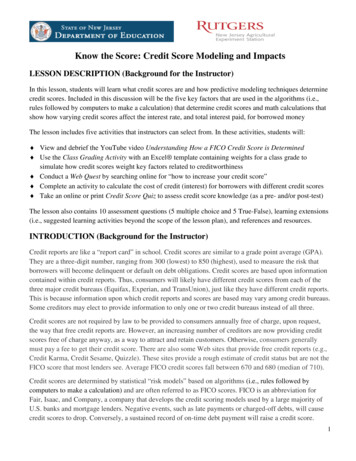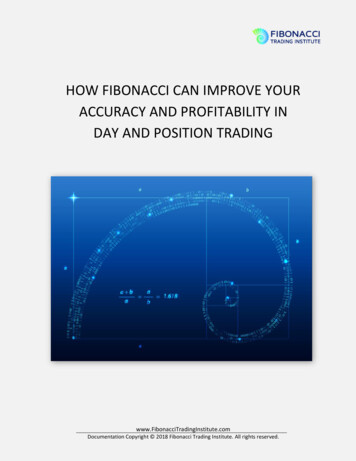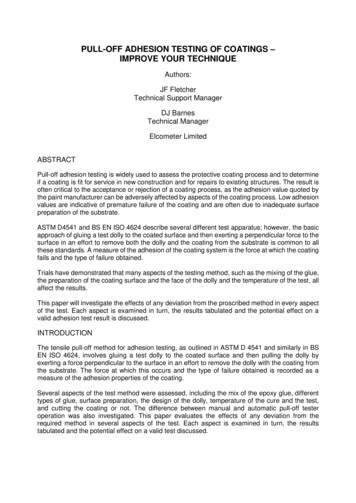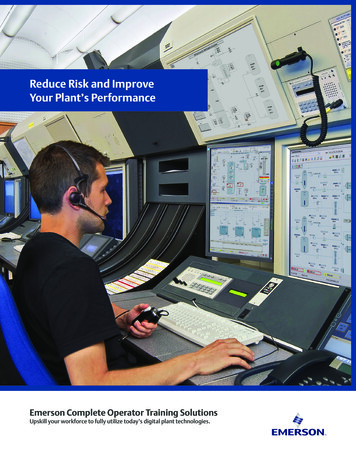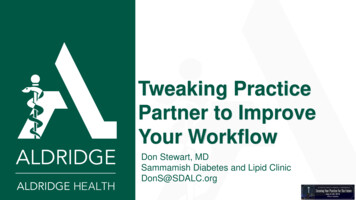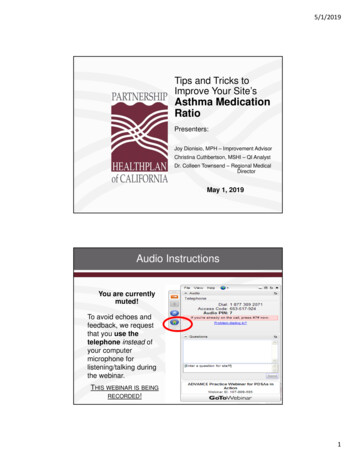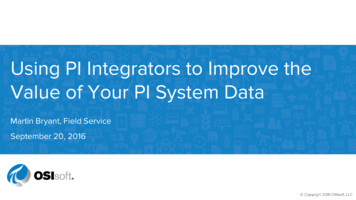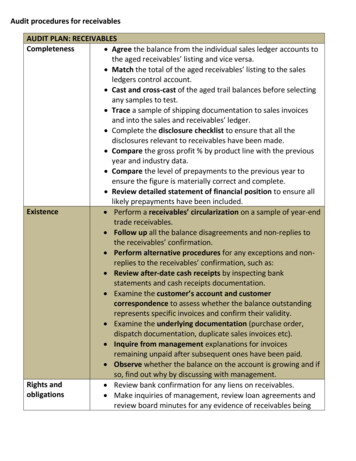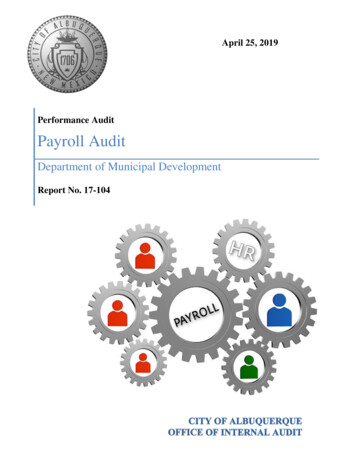
Transcription
Improve Your Audit Score:How to Prevent the Top 10Audit Non-ConformancesJeff Chilton, VP of Consulting Services, Alchemy Systems
Today’s Speaker Jeff ChiltonVP, Consulting Services2
Agenda Audit Process and Significance Top 10 Non-Conformances and Ways To Prevent Them Steps To Take When Non-Conformances Are Found Best Practices for Ensuring Compliance Audit Preparation and Readiness Alchemy Solutions Questions?3
Audit Process and Significance Audits serve as an independent and unbiasedevaluation of your Food Safety and Quality Systems Effective audits should help prevent foodborneillnesses and recalls Every audit should be viewed as a learningopportunity to improve Acceptable audit scores are necessary to meetcustomer requirements Trends in audit scores indicate improvements or issues Compensation is often linked to audit results Goal – Audit Ready, All The Time!4
Audit Challenges Changing GFSI requirements– Updated GFSI Benchmarking– SQF Edition 8 effective 1/1/18– BRC Issue 8 effective 2/1/19– FSSC 22000 Issue 4.1 effective 1/1/18 Unannounced audits Inconsistency amongst Auditors Personnel turnover and training5
Top 10 Audit Non-Conformances & Prevention6
Top 10 Major Non-Conformances (SQF Audits)ClauseDescriptionNon-Conformance2.7.2.1Food FraudProgram and Vulnerability Assessment2.4.8.1Environmental MonitoringRisk-Based Program for ALL facilities11.2.13.1Cleaning and SanitationProgram, Procedures and Effectiveness Verification2.4.3.13Food Safety PlanCCP / PC Monitoring Procedure Methods/Frequency11.2.12.2Pest PreventionIdentified Pest Activity11.7.6.2Detection of Foreign ObjectsMetal Detector Monitoring, Verification, Validation2.5.5.1Internal Audits and InspectionsSQF System Audits with Checklist; Annual Review11.2.12.1Pest PreventionPest Prevention Program Effective Implementation2.5.1.1Validation and EffectivenessValidation of GMP’s, Critical Limits and Changes2.4.3.2Food Safety PlanImplementation & Monitoring;FS Control/Assurance7
Top 10 Minor Non-Conformances (SQF Audits)ClauseDescriptionNon-Conformance2.7.1.3Food DefenseChallenge Test and Plan Review Annually11.2.9.2Equipment, Utensils & Protective ClothingEquipment and Utensil Condition11.4.1.1Staff Engaged In Food HandlingProduct Handling, Off Floor, Traffic, Waste, Eating2.4.3.7Food Safety PlanFlow Diagram Completely and FST Verification11.2.13.1Cleaning and SanitationProgram, Procedures and Effectiveness Verification11.2.3.1Walls, Partitions, Floors & CeilingDurable construction and kept clean2.7.2.1Food FraudProgram and Vulnerability Assessment2.2.3.2RecordsLegible and verified to show complete monitoring2.1.3.2Management ReviewMonthly Practitioner Meetings; Annual SQF Review11.2.7.1Dust, Insect & Pest ProofingExterior doors and openings protected from pests8
2.4.3 Food Safety Plan HACCP / Food Safety Team Training HACCP / Food Safety Team Meeting Schedule HACCP / Food Safety Plan Components – Product Description, Flow Chart, HazardAnalysis, HACCP / PC Plan Summaries Validation Data Supporting Documentation for CCP’s and Hazards CCP Monitoring and Verification Personnel Interviews CCP Records Annual Review – recommend 3rd Party Reassessments9
2.4.8 Environmental Monitoring Program Risk-Based Program Documented Risk Assessment for potential hazards thenassessment to determine which hazards to monitor Written Program to specify sampling and testing schedule, number of samples, andfrequency of sampling Plant survey to determine sampling sites and frequency based on risk Sampling justification supported by regulatory, trade association or scientificguidelines Records for sampling and corrective actions Trend analysis of results10
2.7.2 Food Fraud Written Food Fraud Program Documented Vulnerability Assessment of site and raw materials Documented Mitigation Plan to reduce risks Annual review and program updates as Correlation with FDA Food Safety Plan Hazard Analysis for EMA hazards Tools – PWC Vulnerability Assessment, Food Fraud Database, Horizon Scanfor supporting documentation11
2.7.1 Food Defense Senior Management ResponsibilityDefined Written Program to identify proceduresfor site access, employee access,storage, sensitive processing points,transportation New Requirement – Plan must bechallenged at least annually Reviewed annually12
11.2.9.1 and 2 Equipment and Utensils Equipment, conveyor belts and utensils maintained in acceptable condition and in amanner to prevent contamination New requirement for documented procedure for Purchasing Equipment, Materialsand Protective Clothing to assure it is food grade and suitable for intended use Plant Internal Audit inspections should include the facility, equipment and utensilsin addition to GMP Compliance, Product Handling and Product Labeling Use Preventive Maintenance Programs, Work Orders and Plant ImprovementPrograms to manage the processes13
Steps To Take For Non-Conformances14
During The Audit Communicate closely with the Auditor to clearly understandthe nature of the non-conformance Review the Standard Clause carefully to assess what is notin conformance with the requirement to agree or disputewith the auditor Take before and after pictures of non-compliant areas toinclude with corrective actions when required later Correct non-conformances as soon as possible and show theAuditor corrected areas to demonstrate commitment andsponsorship Ask the Auditor for an exit meeting each day to reviewresults and assure agreement with nonconformancesidentified and ratings assessed at the final exit meeting15
After The Audit Work with your Food Safety Team to determine appropriatecorrective actions to take for each non-conformance identified Investigate and determine the root cause of each nonconformance Complete a CAPA (Corrective Action and Preventive Action) recordfor each non-conformance Complete the Corrective Action Forms required by theCertification Body Submit corrective actions to the Certification Body preferably aweek before the deadline but definitely by the deadline date Follow up with the Auditor to assure the non-conformances areclosed Appeal if warranted16
Best Practices for Ensuring Compliance17
Know The Standard Requirements Be familiar with the standard you are beingaudited to Pay particular attention to updated / newprogram requirements Take training where needed to meetrequirements or raise awareness such as HACCPTraining, Implementing SQF, SQF Quality Course,SPC Training etc Learn from the Standard Owner and othersexperience18
Effective Internal Audit Processes Create an Internal Audit Team and train your Internal Auditors Create an Internal Audit Schedule Complete a clause by clause Gap Analysis or Internal Audit usingthe standard checklist Complete a Corrective Action Register for non-compliant areas Complete a detailed Plant Inspection to assess readiness withpictures; Interview employees during Internal Audits Report Internal Audit Results to Senior Management to promptaction Assure there are not any surprises during the audit19
Food Safety Plan Be certain your Food Safety Plan is fully implemented and validated– Complete and verified Flow Diagram– Correct Hazard Analysis with all hazards identified and assessed– Correct CCP or Preventive Control Steps identified for Process, Allergens, Sanitationand Supply Chain Complete Food Safety Plan Reassessments at least annually and when necessary forCCP failures, significant changes, unanticipated hazards or when new informationbecomes available Complete HACCP / Food Safety Plan Validation with sufficient supportingdocumentation available for review20
Audit Preparation and Readiness21
Audit Preparation Complete SQF, HACCP and GMP Awareness Training with allemployees Conduct a HACCP / Food Safety Team Meeting the week priorto the audit Complete a detailed Plant Inspection, address any employee,equipment, sanitation and maintenance issues identified Inspect all equipment, conveyor belts for frayed edges andutensils Remove any mobile unused equipment from production areas Schedule the Pest Control Operator for an inspection the dayprior Check storage areas for proper housekeeping and allergensegregation Schedule products with minimal waste and ease of processing22
Personnel Coaching Prepare employees for interviews by education them on how to answer questions Auditor will interview QA Technicians, CCP / PC Personnel, Line Operators,Supervisors, Maintenance, Sanitation, Receiving, Shipping and others Assure employees are competent to explain their responsibilities and review anyrecords they complete as part of their job Assure all employees can explain the following:– What is the standard being audited?– GMP requirements for handwashing, glove use, product handling, etc.– Job specific responsibilities23
During The Audit Demonstrate sponsorship at the Exit and Closing Meetings with attendance by seniormanagement and each departmental manager Run lines at appropriate speeds for effective proper product handling, housekeeping andsanitation, and have extra sanitation personnel monitoring Have an advance team inspecting ahead of the auditor Have a key QA, Operations, Maintenance and Sanitation representative accompany theaudit team during inspections Assure proper product and allergen handling / labeling in all areas Do not allow Contractor’s in the plant on audit days Take pictures and detailed notes of any non-conformances identified24
Alchemy Solutions25
Provide Engaging Training Create content in employee’s primarylanguage Base content on employee’s role(HACCP, GMPs, GAPs) Ensure comprehension with opendiscussions and educational gamesFamiliar, site-specific images increase relevancefor workers and improve comprehension.26
Reinforce Critical ConceptsMobile Coach App Increasesupervisor/employeeinteraction &communication Validate employeeHuddle Talk Guides Blueprint to engage& instruct workers Time-saving tool forsupervisors &trainersunderstandingDigitalSignageDigital SignageCoordinatedPostersPostersCoordinated ReinforceReinforcekeykeytrainingtopicstraining topics Improve control & messageImprovequalitycontroltoand messageentirecompanyquality to entirecompanyReinforce discussion Reinforcediscussiontopicswithtopics with strategicallyplaced postersstrategicallyplaced postersMake an emotionalimpact27
Ensure Audit-ReadinessLeverage technology to verify: Training attendance Training comprehension Correct application of training On-the-floor reinforcement and correctiveactionsEliminate time-consuming record keeping!28
Alchemy’s Consulting Solutions SQF, BRC and FSSC 22000 Consulting – Gap Analysis, ProgramDevelopment, Internal Audits, Audit Support HACCP Plan / Food Safety Plan Reassessment – Receive adetailed review of your HACCP system to verify accuracy andeffectiveness HACCP Plan / Food Safety Plan Validation – Receive scientificand/or in-plant data to verify the effectiveness of your HACCPPlan100% ClientSatisfactionRate Food Safety Training – On-site Basic HACCP, Advanced HACCP,Preventive Control for Human Food, Preventive Control forAnimal Food, Internal Auditor Training29
Get Accredited Online HACCP TrainingBasic HACCP Basic HACCP Juice & Beverage Advanced HACCP Accredited by the International HACCP Alliance Receive a certificate of completion Teaches you how to develop & implement an effective food safety plan based onCODEX HACCP specifications, which is required by the four major GFSI schemes– SQF, BRC, FSSC 22000, and IFSLearn more at: y/coursesexams/haccp/
THANK YOUJeff Chiltonjeff.chilton@alchemysystems.comSchedule a Free 30-minute consultationTelephone Andy Chilton: 706.483.4400or email at solutions/professional-services
–SQF Edition 8 effective 1/1/18 –BRC Issue 8 effective 2/1/19 –FSSC 22000 Issue 4.1 effective 1/1/18 Unannounced audits Inconsistency amongst Auditors Personnel turnover and training. 6 Top 10 Audit Non-Conformances & Prevention. Top 10 Major Non-Conformances (SQF Audits) 7 Clause Description Non-Conformance 2.7.2.1 Food Fraud Program and Vulnerability Assessment 2.4.8.1 .
